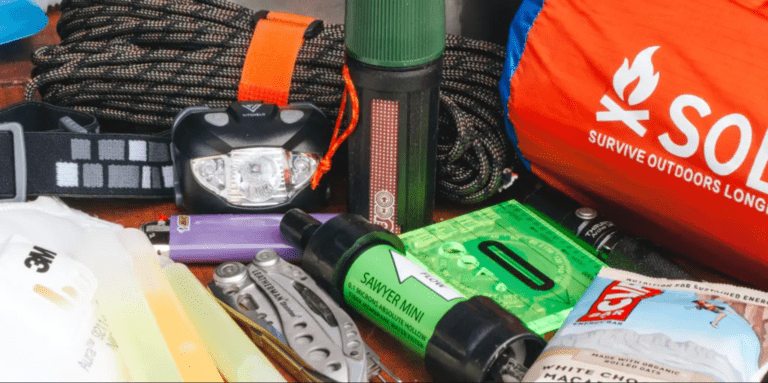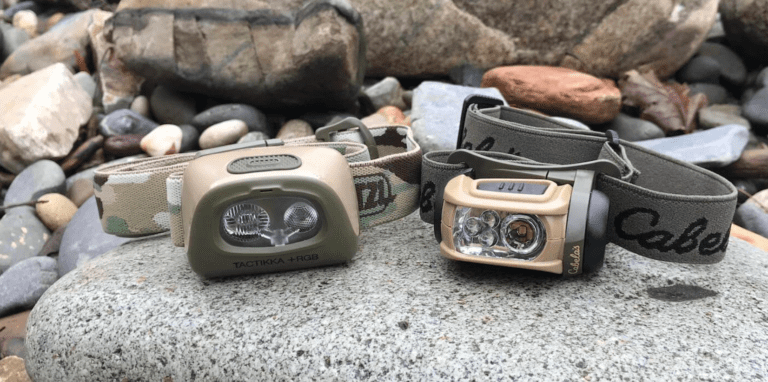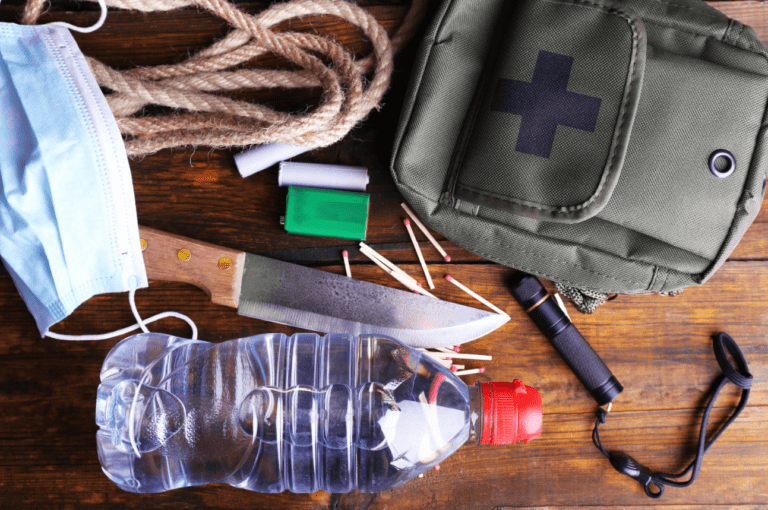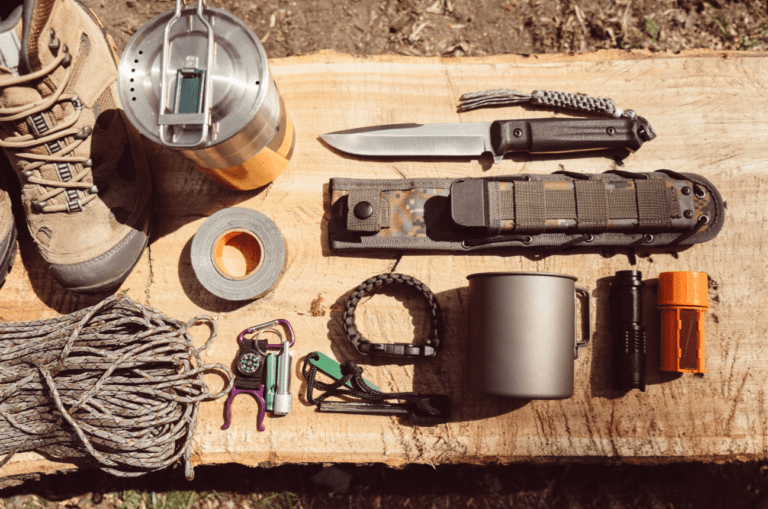How to choose the best tarp for survival shelters
Tarps can be really valuable survival tools. But what if your budget is limited and you need a lot of people to work efficiently? Here are some tarp materials that have worked for me.
A thunderstorm is headed your way. Or you need shade from the blazing desert sun. Or you’re lost, the snow is deep and a storm is coming. In any of these different situations, a tarp can provide the best shelter available.
Now, if money is no object, go out and buy a lightweight nylon tarp with grommets at an outdoor store. But let’s say you have a limited budget (who doesn’t?) and you want the best shelter tarp available within your budget. Or possibly, you’re building multiple survival/preparation kits, and need to be economical but don’t want to compromise on quality.
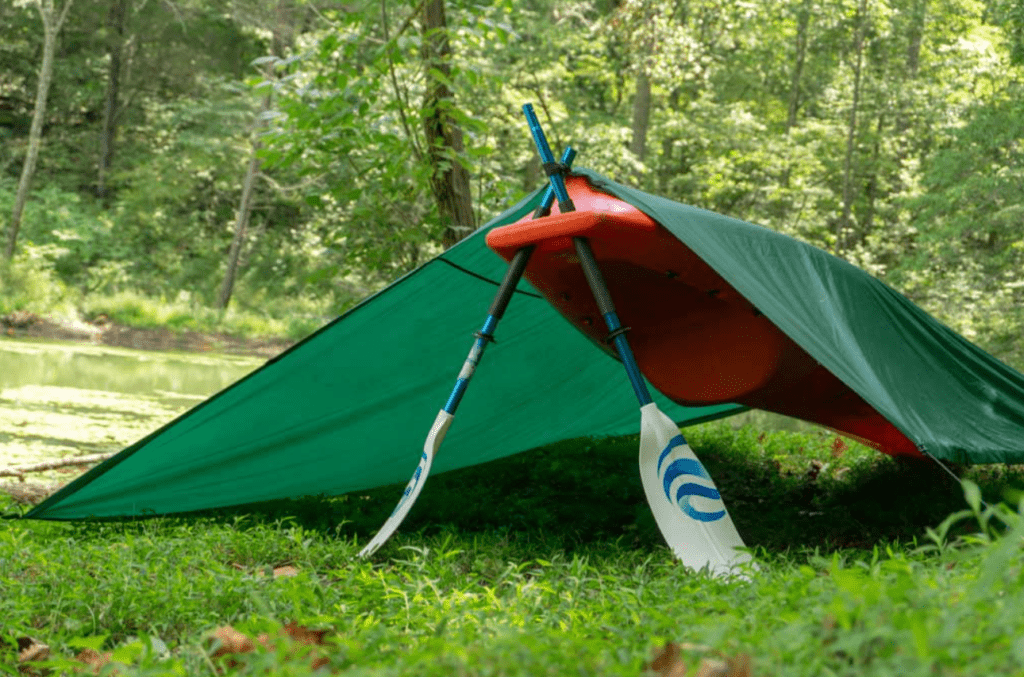
Here’s how to choose the best tarp for your survival needs and budget.
Visqueen or Tyvek: Visqueen is a plastic sheet material used for various construction purposes. Tyvek is commonly used by home builders as a moisture barrier between exterior walls and siding. It usually comes in large, industrial-sized rolls.
In August 1976, I hiked the 225-mile John Muir Trail in California. My only shelter was a 10-foot-by-12-foot, opaque four-millimeter-thick piece of viscose. Despite nine straight days of rain, the Viscoyne kept me dry at night and during frequent afternoon showers.
My reasons for using Visqueen were simple: I had to lose weight, I didn’t have a tent and I couldn’t afford to buy anything else.
Shelter reviewed for bugging out.
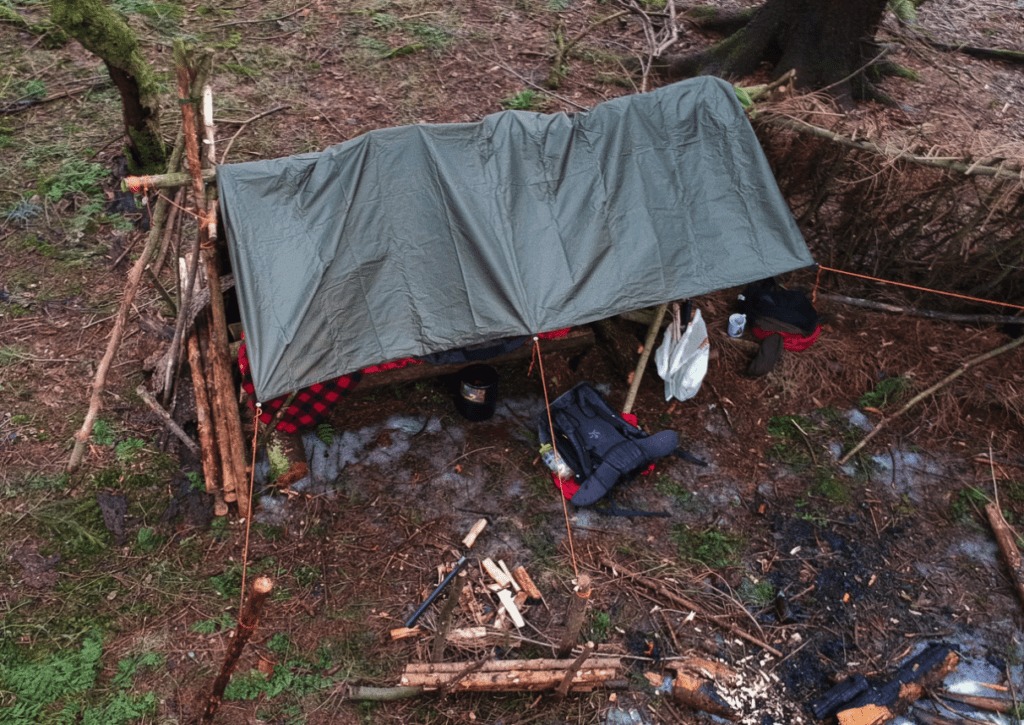
I’ve always been a huge fan of sleeping under a tarp with the moon and stars. In fact there is no occasion where I would go into the bush without a tarp in my pack even when I have a tent to sleep on. Yes, it’s a shelter, but the humble survival tarp is also useful for storing water, carrying loads, making stretchers, making rain gear or as a ground sheet.
The versatility of a tarp is second only to the versatility of the number of shelter configurations you can pitch with it.
When choosing a survival tarp there are several factors to consider before clicking ‘Add to Cart’. At a glance, here are our top picks:
What to Look for in a Survival Tarp:
Size and shape
I am a big fan of square tarps because of the number of shelters that provide square tarps. For shelter purposes an 8′ x 8′ tarp should be considered the minimum for one person to stay comfortable and dry. I prefer to use a 10′ x 10′ tarp which not only provides plenty of room for me and my gear, but also allows me to sleep well in thunderstorms while staying warm and dry. Rectangular tarps are a great option but I find them limited to a few different pitches but are great for a basic tilt or classic A frame.
Depending on how many people are in your group you may want to choose a larger tarp but there will be a weight penalty and larger tarp shelters will be more difficult to pitch with.
Durability
If your tarp is going to be used a lot, the durability of the material will be very important. Think about what the tarp will be used for the most and then check customer reviews before you buy. If your tarp is going to be a workhorse, you need something that is exceptionally durable and perhaps heavier and thicker. Whereas if your tarp will be strictly for shelter and nothing else, a reduction in stability may be a good choice to save weight.
Weight
Tarps are lighter than tents, but some tarps are lighter than others. Depending on the application, the weight of your tarp may be a determining factor in your decision. For example, if choosing a tarp for a bug out bag or daypack, size and weight will be considered. If you plan to use these tarps instead of a tent, then taking a small weight penalty to have a larger and more durable tarp may be the way to go.
Tie-out or grommet
Full disclaimer, I hate grommets with a passion. To me, grommets are just metal rings ready to tear off the corner of your nice new tarp the first time the wind picks up. However, tie-out loops are the best and safest way to tie down your tarp, just make sure the parts that have the loops are sufficiently reinforced.
Placing them at the center seam is very useful when it comes to tie-outs and especially to provide more headroom for attaching a line to raise the center of the tarp shelter. Making sure there are plenty of tie-outs around the perimeter of the tarp will help you use a wider variety of pitches.
Waterproof
It goes without saying, but if your tarp has seams, it has the potential to leak. Before taking the survival tarp out into the field, be sure to test it with a garden hose and clean up any leaks you may find. Most tarps come with a coating to waterproof the material but these coatings can and will wear with time and abuse. If you take care of your tarp though you can expect years of rain ahead.
Now that you know what to look for here are my top picks.
Best Survival Tarps: My Top 5 Picks for Tarp Shelters
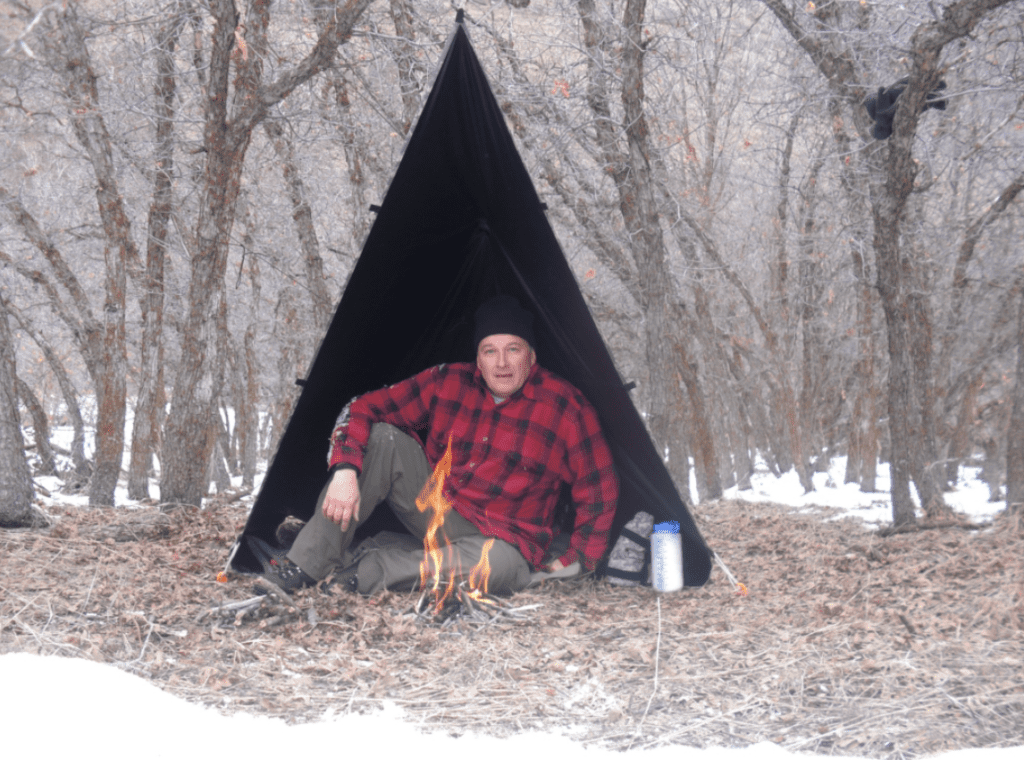
1. Best Survival Tarp (Overall) – AquaQuest Safari Tarp Review
Aqua Quest is a popular brand name when it comes to tarps and it was an easy decision to put it at the top of my list. This particular tarp model comes in various sizes and olive drab and camouflage color schemes. The 10′ x 10′ version comes with a stuff sack with 19 tie-outs, 6 boa straps and 6 stakes to put it all in. Boa straps are an interesting feature, instead of the length of the guy line they are nylon straps. Adjustable tension. Maybe I’m old but I’m not completely sold on these boa straps being any better than my usual paracord and trucks hitch setup.
Features
- Available in 10′ x 7′, 10′ x 10′, 10′ x 13′, and 20′ x 13′
- 70D nylon fabric
- There can be 15 to 25 tie-outs depending on the size.
- Boa comes with leash, stake and stuff sack.
- Boa straps are 4′ long and have adjustable tension.
- 10′ x 10′ packed size compresses to 12″ x 5″ x 3″ 6″ x 6″ x 4″
- Lifetime warranty
Pros
- The 10′ x 10′ version weighs just 1.6 pounds.
- Plenty of tie-outs and no grommets.
- Comes with enough straps and stakes to pitch a wide variety of shelter configurations.
Cons
- It doesn’t have the snaps that the Snugpak does.
- Boa straps can’t hold up to the versatility of traditional guy lines or paracord.
2. Runner Up – Singpak All Weather Shelter Review
The Snugpak All Weather Shelter is a great survival option from a company known for producing high-quality gear. Although this tarp has terrible grommets, the good folks at Singpak threw me a bone and added a tie-out with the grommets. This 2.2 pound 10 x 10 tarp comes with a nice zippered case, 4 ten-foot guy lines and 8 tent stakes. Coming in only one size option is a bit of a downside, but the 10′ x 10′ tarp is a great option for one or two people to comfortably sleep under. One feature that caught my eye was the snaps that are included with the opposite edges of the tarp to convert it into a bivy, which probably won’t matter to most people but for users who want to wrap in a tarp. I don’t mind. . The addition of these pictures on the ground is a definite bonus.
Features
- 10′ x 10′ 210T Rip Stop Nylon
- 4 Ten-foot man lines
- 8 Tent stakes
- Olive seed
- 2.2 pounds
- Size 8″ x 8″ x 3″ packed in a zipped case.
Pros
- Pictures with opposite edges that turn a tarp into a wife.
- Too many tie-outs
- light weight
- The man comes with lines, stakes, and a case
Cons
- Only one size available.
- There are grommets
3. Best Lightweight Tarp to Bag Out – Aqua Quest Guide Tarp Review
It is a very light version of Aqua Quest Safari and Defender Traps. With a 10′ x 10′ option that weighs 1.2 pounds and is compressible to a smaller 6.25″ x 6″ x 4.5″, it’s a great option for your bug out bag, especially If you want to leave the tent. A shelter option. This is a complete tarp shelter package with buoy straps, stakes, and stuff sack. My only concern with a setup like this is the durability of such a light and thin material. Yes, but if you are careful and mindful of how such a lightweight tarp is handled it should be manageable.
Features
- Available in 10′ x 7′, 10′ x 10′, 10′ x 13′, and 20′ x 13′ options.
- 40D ripstop fabric
- Boa comes with leash, stake and stuff sack
- Between 13 and 21 tie-outs depending on the size of the tarp
- 10′ x 10′ packed size compresses to 11.5″ x 4.5″ x 3″ 6.25″ x 6″ x 4.5″.
- Lifetime warranty
Pros
- The 10′ x 10′ version weighs just 1.2 pounds.
- Plenty of tie-outs
- Straps and stakes can be used to pitch a variety of tarp configurations.
Cons
- Lighter and thinner materials may lack durability.
4. Best Survival Tarp for Daypack – S.O.L Survive Outdoors Longer Utility Blanket Review
This is a tarp that is always in my hiking daypack and I’ve set it up in a few configurations on a few occasions, and it’s great for an emergency shelter. I wouldn’t hesitate to spend a night under one of these which is why it’s always in my day pack along with some aluminum stakes and a length of paracord. Weighing only 11.3 ounces and packing up to 13″ x 7.8″ x 2.5″, you’ll hardly notice it’s in your pack. The tarp itself is 5′ x 7′ which isn’t an ideal shape or size but It can be made into some nice configurations. Unfortunately it has 6 grommets instead of tie-outs and doesn’t come with any guy lines or stacks. Another nice feature is the reflective side which covers 95% of your body. will reflect the heat back to you.Overall though this is a good option for emergency shelter.
Features
- Orange on one side and reflective on the other which is claimed to reflect 95% of body heat.
- 5′ x 7′ with 6 grommets
- It weighs only 11.3 ounces.
- Packed Size 13″ x 7.8″ x 2.5″
- Comes with resealable bag
Pros
- light weight
- The reflective side reflects 95% of body heat.
- The resealable bag has room to store tent stakes and guy lines.
Cons
- Grommets instead of tie-outs
- No stakes or man lines
5. Best Budget Survival Tarp – Chill Gorilla Review
For those of us who don’t have the budget for Aqua Quests or Snugpaks, or just want a nice tarp that won’t be the pain of a lost or damaged wallet, the Chill Gorilla is a good option. Is. . . This 1.4 pound 10′ x 10′ tarp is made of 210D ripstop nylon and has 6 guy lines, 4 stakes and a stuff sack to carry it inside. Which I’m not entirely comfortable with because I’ve seen too many plastic rings break to trust them.
Features
- 210D ripstop nylon
- 10′ x 10′ tarp packs up to 12″ x 4″ in a stuff sack
- The man comes with lines and stakes
- D ring tie out
- Weighs 1.4 pounds
Pros
- light weight
- The man comes with lines and stakes
- Center is a tie out.
Cons
- Plastic D-rings can be prone to wear and tear, as can tie-out grommets.
- Only one size option
How should I care for a survival tarp?
First and foremost, under no circumstances should you keep any tarps wet. Always hang to dry before folding and storing in its stuff sack. Do not use abrasives when cleaning your tarp, a soft brush and rag with mild soap is enough to clean any dirt from your tarp. When storing the tarp or packing it in your bag, try and avoid trapping any debris between the layers when folding it. Any debris or dirt will act as an abrasion and wear out your tarp much faster.
Why are tie-outs better than grommets?
Grommets are basically a hole in the tarp that is reinforced with a metal ring. The problem with these is that the force of the rope or strap is pulling this metal ring into the already compromised material, and can eventually tear the grommet right off the edge of the tarp. Tie-outs on the other hand are sewn into fabric and reinforced with extra fabric on top of a good quality tarp. The tensile force on the tie-out is distributed over the length of the area to which the tie-out is sewn thereby spreading the load.
What advantages does a square tarp have over a rectangular tarp?
Both forms of tarp have their place and either will give you a bunch of pitch options when setting up the shelter. However, a square tarp provides more shelter than a rectangular tarp. There’s an option for every situation, from a simple plow point to the more complex Adirondack where a rectangular tarp is more restrictive. Ultimately it comes down to personal preference as to what form of tarp you decide to go with.
Is it a good idea to put a tarp under the tent?
It may not always be necessary to put a tarp under your tent, but it is something you can do if you want to create an extra layer of protection for your shelter.
When a tarp is used correctly, it can work to protect your tent from punctures and reduce any mud and water leaks. However, most people use a tarp that is too big for their tent, which can actually cause more problems than it’s worth.
Whether or not you should put a tarp under your tent will depend on the type of tent you are using. Although, it can help protect your tent from punctures and moisture. Another great benefit of putting a tarp under your tent is that it will help keep you warm by providing an extra layer of insulation.
Can you put a tarp over a campfire?
Yes, you can put a tarp over a campfire as long as you do it safely. You should always make sure you are pitching the tarp at a slight angle, with the highest corner of the tarp directly above the fire, and the farthest corner touching the ground.
This will ensure that the smoke can escape. If you put the tarp on the fire, it probably won’t last long.
To make sure the tarp is high enough above the fire, you should place your hand over the fire, close to the tarp, to feel how hot it is.
The best tarp to use for this purpose is one that has been fire treated, but if you don’t have one available, a standard tarp will work just fine. Make sure you never leave your fire unattended.
How thick should the tarp be under the tent?
It doesn’t matter how thick the tarp is under your tent as long as you use the right size tarp. The only thing that will affect how thick the tarp is will be damage.
Obviously, if the tarp is really thin, it can rip open on a rock on the ground and make it pretty much useless. Standard tarps should work, but you have to make sure it’s the right size, or it won’t work.
Unfortunately, there is no tarp size that will work perfectly with every tent, but a general guideline is to buy a tarp that is about 2-3 inches smaller than the actual outside dimensions of your tent.
Do tarps prevent heat?
A tarp will not always block heat, but the level of heat blocking will depend on the type of tarp you are using.
Tarps are great for protecting you from the sun and wind when you’re out in the woods. If you can’t find any shade, you can use a tarp to block out the sun. You can string a tarp between trees or poles for instant shade to help protect you.
This will protect you from the harsh rays of the sun, but it will also keep the heat inside, which may not be what you want.
Some of the best tarps to use to block the heat are those that are white or silver in color. These will provide you with shade from the sun, but they will also reflect sunlight instead of absorbing it.
Are tarps breathable?
Not all tarp types will be breathable, so it’s important to know what you’re buying. Some of the best breathable tarps are canvas tarps, which are strong, durable and breathable.
You can get your hands on a waterproof version of this tarp, but one thing you should be aware of is that not every canvas tarp will be waterproof, and many are only water-resistant. .
Unfortunately, this means that a small amount of water won’t make a difference, but if you’re using them in a really heavy downpour they won’t be effective. If the water can’t get out of the canvas tarp fast enough, it will start to drip through the material.
If you want to buy a canvas tarp for its breathability, you should first check if it is waterproof.
What does Mil mean in Tarps?
When it comes to choosing the right tarp for you, you should know that the term mil is referring to the actual thickness of the tarp. For general use, you can just go for a tarp that is light with a thickness of about 5 mm.
However, for more heavy-duty use, such as camping, you will likely need a tarp that is more heavy-duty, with a thickness of at least 23mm. This will ensure that it is more durable and long-lasting than other thinner types of tarp.
There are also many different materials to consider, such as canvas, vinyl, poly, and mesh, and the definition of heavy duty can vary between these materials.
Generally, a thickness of 12mm would be classed as heavy duty, so the thicker the material the more durable it is. You can even get tarps over 50 miles.
Are tarps UV resistant?
Whether or not the tarp will be UV resistant will depend on the type of tarp you are getting.
There are many different types of tarps that are UV resistant, and these are often the best types for going into the woods. We’ll go over some of the different UV resistant materials you can get for tarps below.
Vinyl coated and vinyl laminated polyester tarps will be able to provide UV resistance, and are also waterproof, highly durable, tear resistant, and mildew resistant. You can get these types of tarps in different weights, thicknesses and colors.
Polyethylene tarps are both economical and lightweight, and will also provide UV protection. Plus, they’re really strong, waterproof, and mildew-resistant.
Mesh tarps are great for providing UV protection, but are also great for providing excellent airflow to keep you cool while you’re under them.
Easy Survival Tarp Shelter: How To
There are a thousand ways you can make a shelter out of a tarp. This is a huge body of knowledge, so I’m going to show you a simple SurvivalistBlog.com system I came up with. The first thing you need is a tarp. The bigger the tarp, the bigger your shelter will be, so keep that in mind when shopping. The one you see here is about 10 x 12 feet and costs about $12. I ran a pole between two trees and then walked a long distance on it. At each end I used paracord through grommets tied to stakes or tree limbs that were readily available. There are a thousand ways you can make a shelter out of a tarp.
Knowledge
It’s a huge body of knowledge, so I’m going to show you a simple system I came up with. Survivalist The first thing you need is a tarp. The bigger the tarp, the bigger your shelter will be, so keep that in mind when shopping. The one you see here is about 10 x 12 feet and costs about $12.
I ran a pole between two trees and then walked a long distance on it. At each end I used paracord through grommets tied to stakes or tree limbs that were readily available. The back of the shelter is about a foot off the ground, but I’ll probably leave it in the winter or pile snow up to it. I wanted the top of the shelter far enough away from the flames that it wouldn’t melt the tarp or catch fire. At one of the top corners I put a carabiner in the middle of the line so that I could easily drop one side of the shelter on the way out, otherwise it would get caught under the weight of water or snow. Will go or fall.
In the middle of the tarp I ran a small pine limb with one flat end up the middle of the tarp. This helps prevent water and snow from drifting off, which helps prevent the tarp from collapsing. As I mentioned earlier there are hundreds of ways you can build a tarp shelter and you are only limited by your imagination. I have a military poncho that I have used to make several shelters, but tarps are large and you can make a good sized shelter for less than a dollar.

